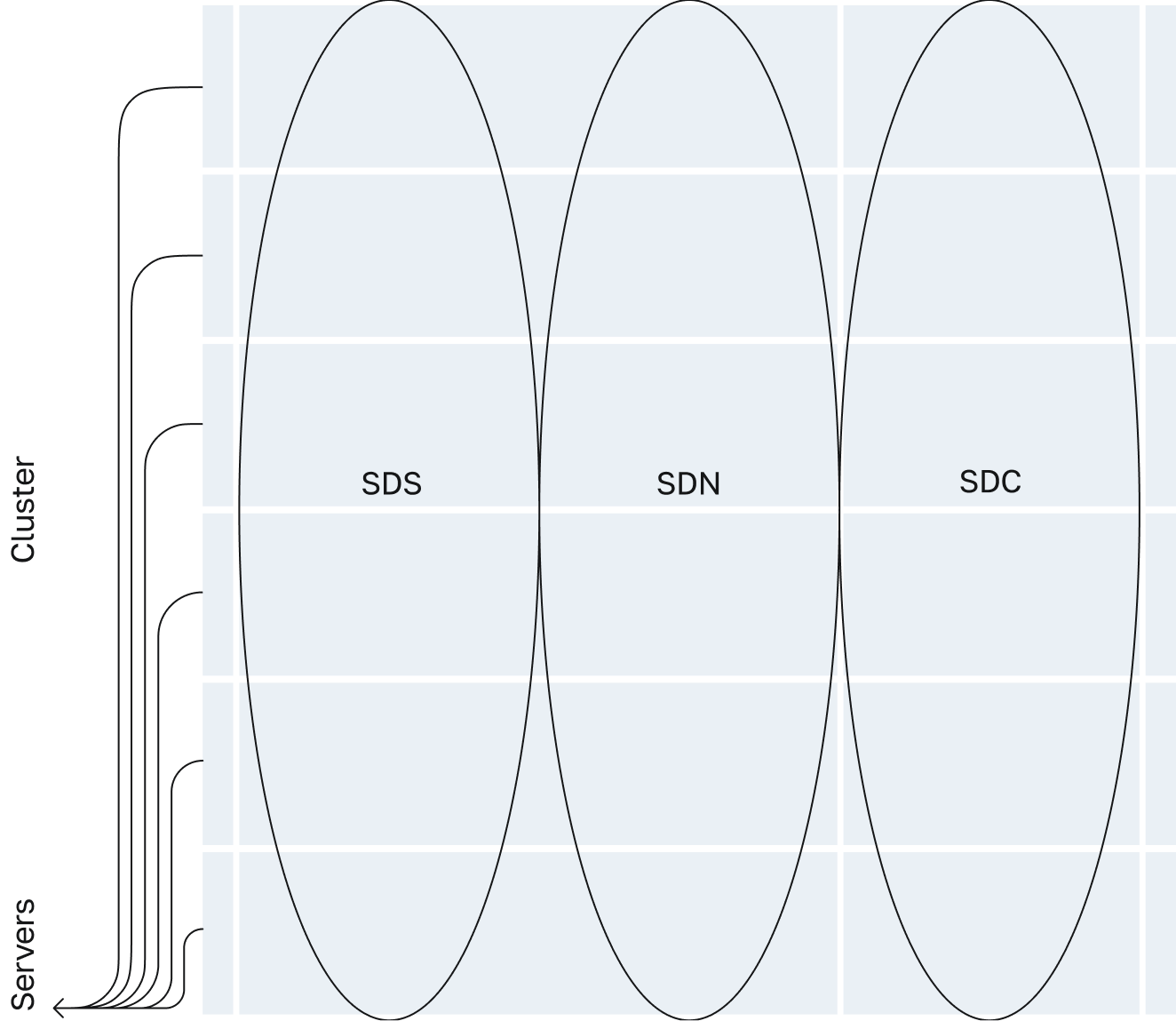vStack HCP — hyperconverged infrastructure with a managed virtual data center
VStack HCP application scenarios
Traditional infrastructure (on-premise)
Horizontally scalable software
Software development and testing environment
Low-cost резервные ресурсы для operations
Infrastructure for remote offices
Virtual desktops (VDI)
Low-cost back-up resources for operations
Infrastructure for remote offices
The vStack platform is suitable for service providers, banks, game developers, E-commerce companies, educational organizations, industrial companies and others.

Features of vStack HCP
Creation of virtual data centers
Start virtual machines in 15-40 seconds
Deleting and managing VMs
Enabling more cores than are available on the physical processor
Snapshots, including saving the NIC configuration
Error correction, deduplication, compression
Creation of isolated networks with support for heterogeneity
Support for cloud VM images with a high level of customization
Applications of vStack HCP
- Public, private and hybrid cloud
- Software development and testing environments
- Traditional on-premise infrastructure
- Infrastructure for remote offices
- Containerization (Kubernetes)
- Horizontally scalable software
- Virtual desktops VDI
- Resilient site
- Low-cost backup resources for operations
- Infrastructure for remote offices Disposable VMs

Frequently Asked Questions
What are the main differences in functionality between a cloud stand and a local on-site installation?
How is the cluster scalability feature implemented and how is node addition handled?
How to expand only memory or CPU?
How can the end client request/configure resources on their own?
Where does the difference between SSD and HDD drives come from when calculating points in the SPP licensing model?
How are the number of disks and nodes related?
Is it possible to present the VM to an external datastore?
How to do VM backups?
Is it possible to replace the disk or noda myself?
Our customers
vStack HCP.
Get a consultation
VStack HCP Architecture
Three traditionally disparate components are united into a single software-defined solution. The platform creates a single cluster space based on servers that perform 3 functions simultaneously:
SDS or Software Defined Storage
Data Storage Layer
SDN or Software Defined Networking
Network
SDC or Software Defined Computing
Computing resources

IT infrastructure is managed from a single control panel. This allows for quick response to incidents and simplifies the work of administrators.

Technology stack
A software-defined network layer in which the control layer is separated from the data devices and implemented programmatically. Its purpose is to separate the management and processing of network data to create a programmable infrastructure.
The vStack SDN has three ways to provision virtualized networks:
- VLAN;
- VXLAN;
- GENEVE.
Each virtual network instance is based on a distributed switch, has its own MTU and supports jumbo frames, TSO/GSO, TCP MSS clamping and path mtu discovery.
Benefits of vStack SDN:
- Flexible management;
- Customizable infrastructure;
- Security, the ability to
- Isolate compromised devices and create zones for buildings with different levels of security;
- Security, the ability
- High throughput from 22 Mps;
- Support for heterogeneous networks out-of-the-box
A computing layer consisting of dynamically pooled software-defined computing resources.
A virtual machine consists of vCPUs, RAM, virtual network ports, and disk devices. The lightweight nature of vStack reduces CPU Overhead (the performance of a virtualized server compared to a physical server) to minimal values. The vStack SDC is effective in CPU overcommit environments, with cost efficiency in the SDC layer as high as 900%.
Comfortable platform operation in the vStack SDC layer is supported:
- Autonomous CPU overcommit mechanism;
- Limit vCPU resources in real time;
- The ability to create VMs with flexible customization;
- Capability to customize guest OS;
- Limit real-time performance;
- Ability to create snapshots of the VM configuration;
A storage layer that provides data storage with redundancy and transactional integrity with automatic data recovery capabilities.
The vStack SDS is based on a file system. The layer consists of pools that include each node’s disks. At any given time, a pool is running on a specific node in the cluster. Redundancy allows for redundancy. If one node fails, it will be excluded from the cluster and the pools will lose one disk. The pool from the failed node and all VMs on it will be available on another node due to the emergency switchover procedure, which is performed automatically.
With SDS you can:
- Create storage pools with cluster redundancy;
- Provide VM disks to the SDC layer;
- Perform compression and reduplication;
- Maintain data integrity;
- Create clones and snapshots;
- Maintain data self-healing and transactional integrity;
HCI infrastructure layer management component. This is a service VM that contains software for storing and modifying system state, component performance information, and system state.
The task of vStack Management is to manage the infrastructure and its components using web interface and APIs, consistent storage of infrastructure object layer data and storage of component performance information.
Software and Hardware Interaction Layer. This is a set of interconnected software for managing hardware resources of the vStack platform. This layer can also be used to provide standardized primitives for application programs.
The vStack OS is required to enable software and hardware utilization.
